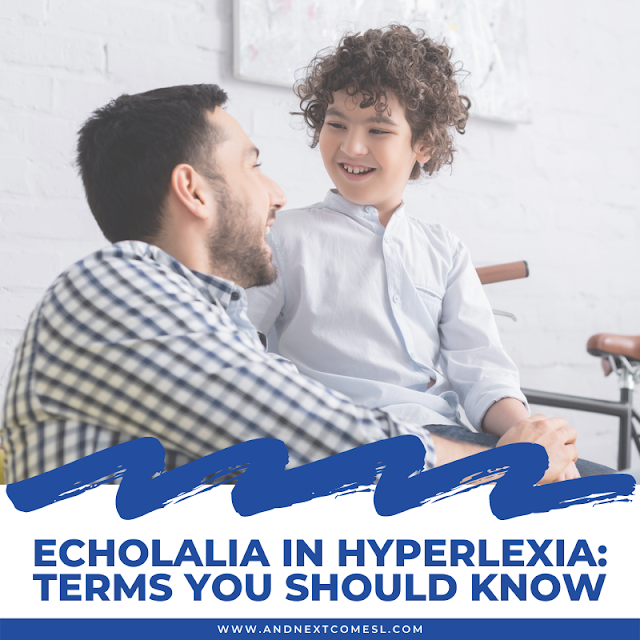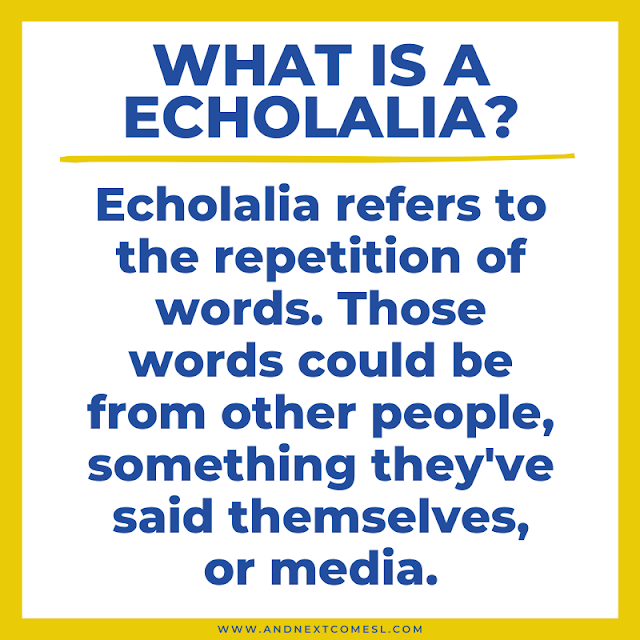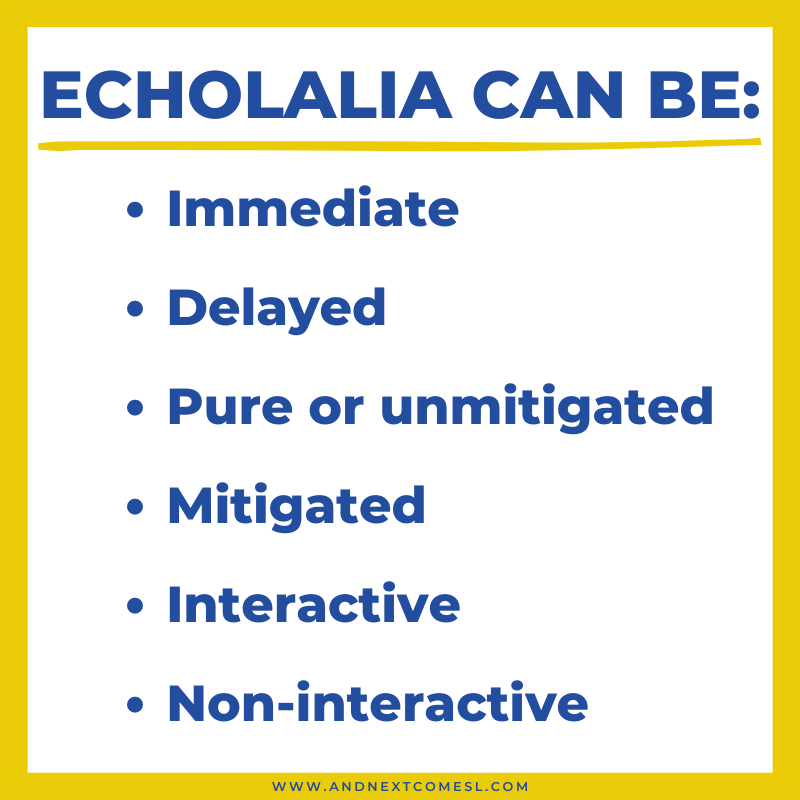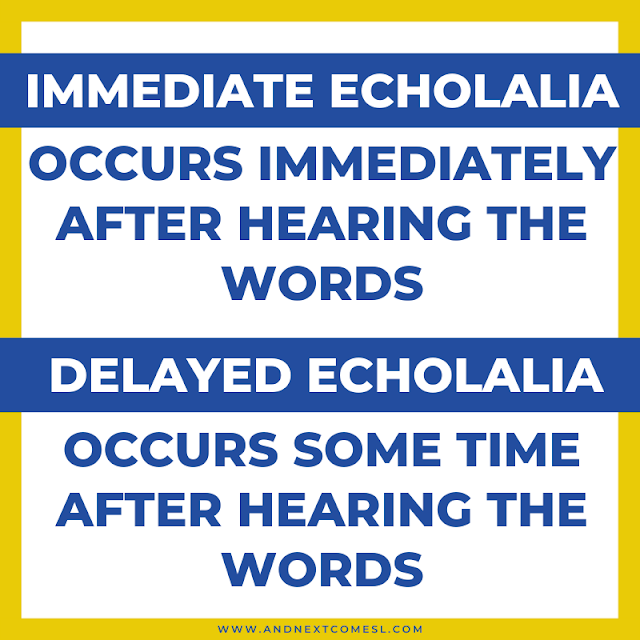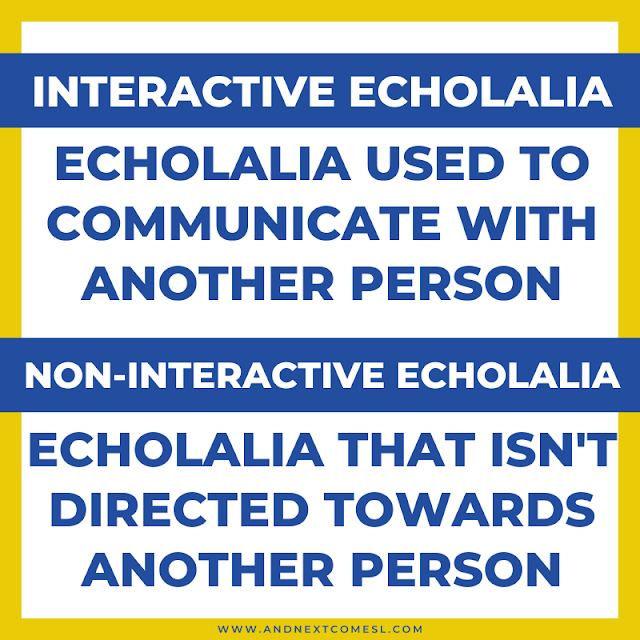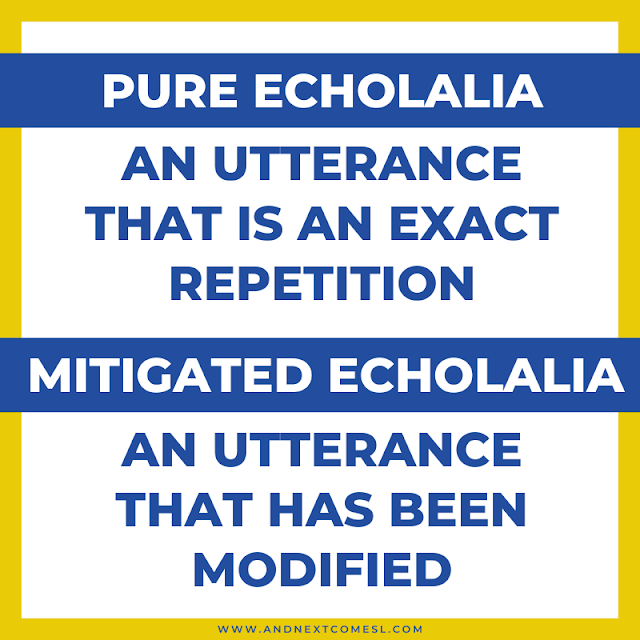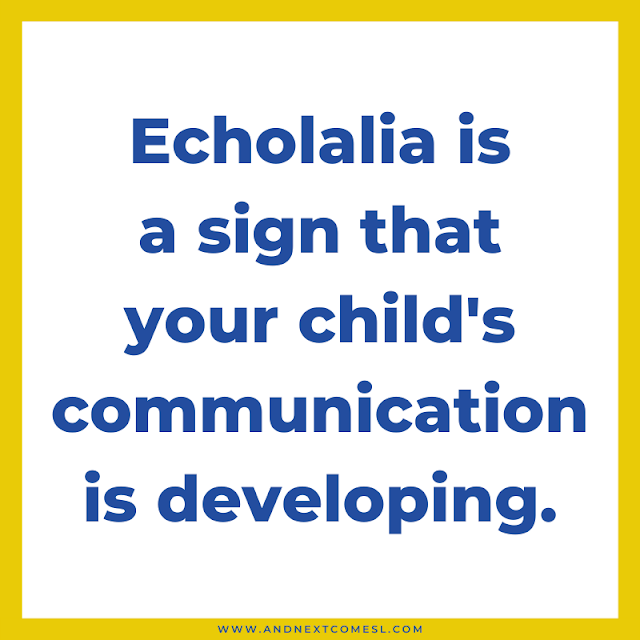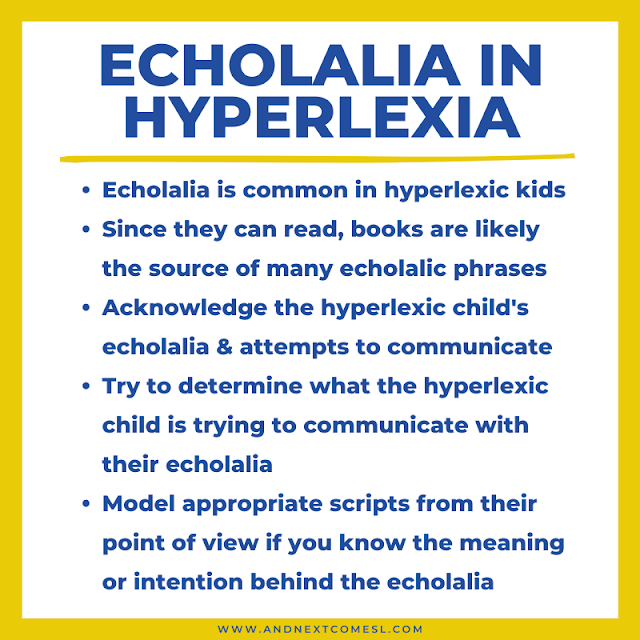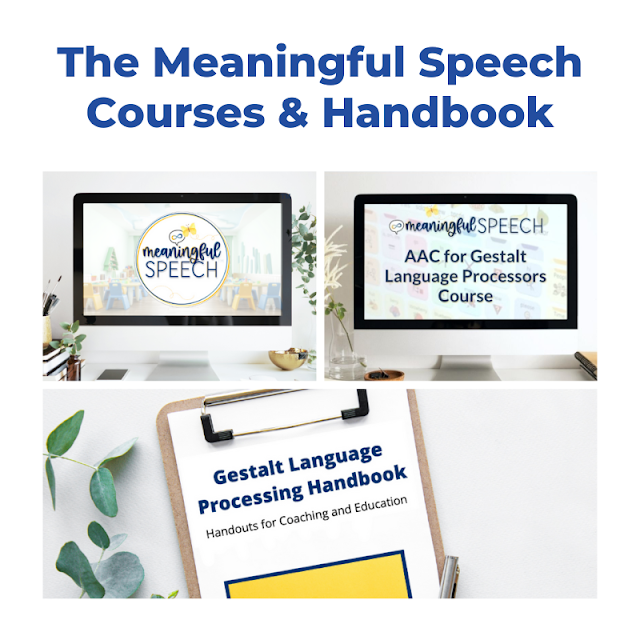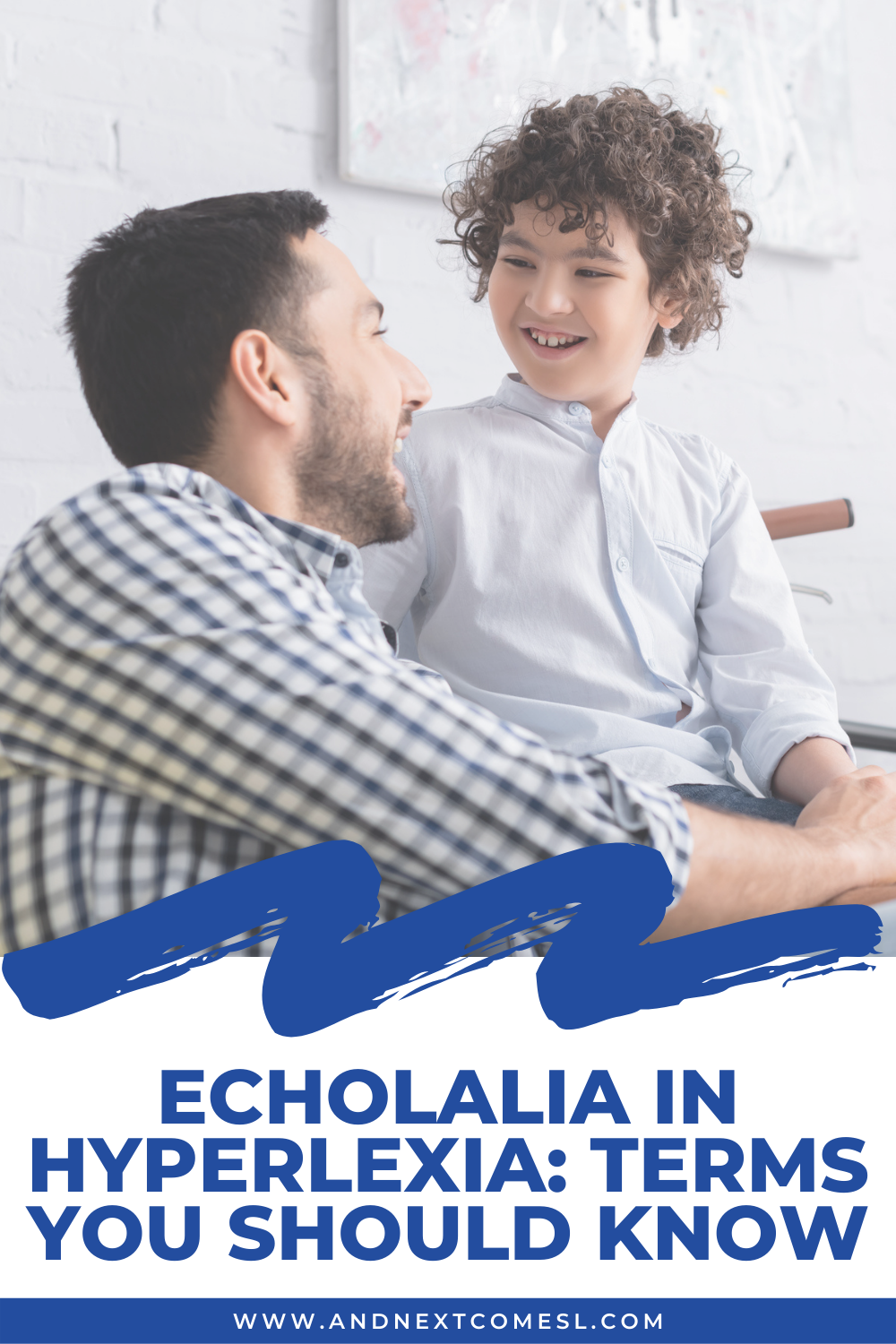Most children repeat and imitate phrases that they hear, especially in the first two years of life. So really some echolalia is a part of normal language development.
However, some kids continue to use echolalia speech patterns beyond the toddler years.
Many of these kids are autistic or hyperlexic and are gestalt processors. For them, echolalia plays a key role in their natural language development. They simply learn language a bit differently.
But what is echolalia exactly?
And did you know that there are different types of echolalia?
Well, we're going to break down all of these terms about echolalia below and discuss its relation to hyperlexia.
So What is Echolalia?
Echolalia refers to the repetition of words.
Those words could be from other people, something they've said themselves, or media (books, TV shows, songs, etc.). They might be repeating a word, a phrase, a whole sentence, or something longer.
Basically, echolalia describes when an individual repeats or imitates something that someone else has said.
In the past, it was thought that echolalia was meaningless and that it wasn't functional communication. So, unfortunately, you might come across outdated definitions that refer to echolalia as such.
But please know that echolalia isn't meaningless. In fact, it's a good sign that communication is developing.
Types of Echolalia
There are two types of echolalia to be aware of:
- Immediate echolalia
- Delayed echolalia
These types of echolalia can either be classified as:
- Pure or unmitigated
- Mitigated
Delayed echolalia can also be broken down further as:
- Interactive
- Non-interactive
So let's take a closer look at what these types and terms mean, as well as some examples of echolalia.
What is Immediate Echolalia?
Immediate echolalia refers to the repetition of words or phrases immediately after hearing them or shortly after hearing them.
For example, you might ask your child, "What do you want for a snack?" and they might reply by asking, "What do you want for a snack?"
What is Delayed Echolalia?
Delayed echolalia is when the repetition of words or phrases occurs some time after hearing them. Basically, there's a distance (sometimes hours, days, weeks, or months later) between hearing the phrase and using the words.
For example, your child might quote a line from a movie they watched a few weeks ago.
Interactive & Non-Interactive Delayed Echolalia
It's also important to note that delayed echolalia can also be classified as interactive echolalia or non-interactive echolalia.
It's considered interactive if the echolalia is being used in an effort to communicate with another person. On the flip side, if it lacks communicative intent and isn't directed towards another person, it's considered non-interactive.
Pure vs Mitigated Echolalia
When an utterance or series of words are repeated exactly the same as they were heard (aka the phrase they utter is an exact repetition or verbatim), it is referred to as pure or unmitigated. For example, you say, "Want some milk?" and they repeat, "Want some milk?"
When some of the words are changed or modified, then we call that a mitigation. We would say that the utterance is mitigated. An example would be the phrase "Let's go outside!" turning into "Let's go home!"
Echolalia in Hyperlexia
You likely know that echolalia is common in hyperlexia. You've probably witnessed and experienced it yourself with your child.
You likely also know that hyperlexic kids learn via gestalt processing.
Well, that's not surprising given that echolalia is a sign of gestalt processing. After all, gestalt language learners learn language in chunks and guess what echolalia is? Chunks of language!
Since our hyperlexic kids can read, their repeated phrases are more likely to come from books they've read. But they will also echo phrases from other sources like YouTube videos or TV shows. Sometimes in other languages too...
As I mentioned earlier, echolalia is a sign that your child's communication is developing.
When your child repeats a phrase, they're showing an intent to communicate. Sometimes what they're trying to communicate might not be immediately clear, but with a little investigation, you can often figure out the meaning behind their echoed utterance.
As Sussman says in the book More than Words, "The words your child learns from echolalia open the door to meaningful communication."
Historically though, echolalia has been referred to as non-functional communication. Yet, echolalia absolutely is functional communication. A child might be using echolalia to calm themselves, practice talking, express emotions, request things, answer questions...really a number of things! And I think we can both agree that using repeated phrases to communicate those things is indeed functional.
For example, a hyperlexic child might recite the alphabet over and over to help them regulate. Or they might say a line from a Numberblocks episode to communicate that they are feeling happy because the Numberblock was happy when they said that particular phrase. Or your child might repeat your question back immediately after you asked it as a way to mean yes. Or they might say "Chicka Chicka Boom Boom" when something falls down.
So when it comes to echolalia in hyperlexia, it is important to acknowledge their attempts to communicate, not ignore it. Try to respond to their echolalia in a way that makes sense.
You also should try to dig deeper to see if you can determine what your hyperlexic child is communicating and then try to communicate back that you do indeed understand their intention. You can do this by modeling an appropriate script and giving them the words they need to communicate that. Just be sure to phrase your modeled script as if they were saying it themselves. For instance, say "I want juice" vs "Oh, you want juice."
Want to Learn More About Echolalia and Natural Language Acquisition?
If you'd like to learn more about echolalia and how to help a hyperlexic child move from echolalia to novel, spontaneous language, I highly recommend checking out the Meaningful Speech courses and their Gestalt Language Processing Handbook. Learning about the stages of Natural Language Acquisition is a complete gamechanger! Use coupon code DYAN to save 5% on the handbook or courses.
Learn more about the Gestalt Language Processing Handbook & Courses
So Let's Recap...What is Echolalia & How Does it Relate to Hyperlexia
- Echolalia refers to the repetition of words
- It can be immediate (occurs immediately after hearing the words) or delayed (occurs some time after hearing the words)
- Delayed echolalia can be broken down into interactive (the echolalia is used to communicate with another person) and non-interactive (the echolalia is used for personal use and isn't directed towards another person)
- Echolalia can be pure/unmitigated (an exact repetition) or mitigated (a modified version of the phrase)
- Echolalia is a good sign that communication is developing
- It is not meaningless despite what other definitions might say (those definitions are outdated)
- Echolalia is functional communication (again, despite what other definitions might say)
- The presence of echolalia means that they are a gestalt learner
- Echolalia is common in hyperlexic kids, which isn't surprising because hyperlexic kids are also gestalt learners
- The echolalic phrases that hyperlexic kids use are more likely to be from books since they can read
- You should acknowledge and respect your hyperlexic child's echolalia and attempts to communicate
- You should dig deeper to try and figure out what the hyperlexic child is trying to communicate when they use echolalia
- You should model appropriate scripts from the hyperlexic child's point of view if you've figured out the meaning or intention behind their echolalia
So, hopefully you found this information on echolalia in hyperlexia helpful!
Other Hyperlexia & Language Development Resources You'll Love
Gestalt Learning & Hyperlexia: What Does it Mean to be a Gestalt Learner?
40 Language Skills that Hyperlexic Kids Might Need Support With


